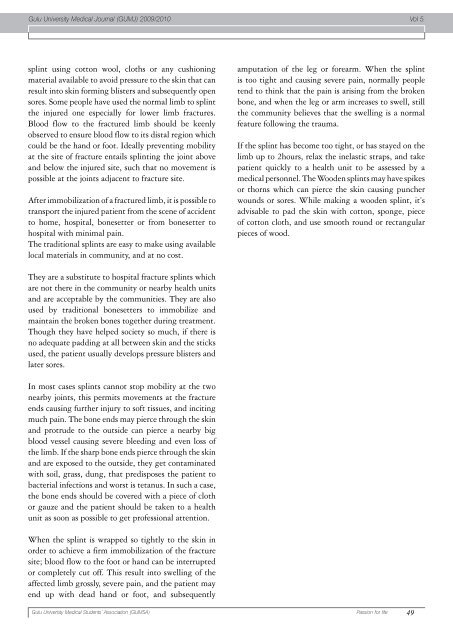GULU UNIVERSITY MEDICAL JOURNAL
GULU UNIVERSITY MEDICAL JOURNAL
GULU UNIVERSITY MEDICAL JOURNAL
Create successful ePaper yourself
Turn your PDF publications into a flip-book with our unique Google optimized e-Paper software.
Gulu University Medical Journal (GUMJ) 2009/2010 Vol 5.<br />
splint using cotton wool, cloths or any cushioning<br />
material available to avoid pressure to the skin that can<br />
result into skin forming blisters and subsequently open<br />
sores. Some people have used the normal limb to splint<br />
the injured one especially for lower limb fractures.<br />
Blood flow to the fractured limb should be keenly<br />
observed to ensure blood flow to its distal region which<br />
could be the hand or foot. Ideally preventing mobility<br />
at the site of fracture entails splinting the joint above<br />
and below the injured site, such that no movement is<br />
possible at the joints adjacent to fracture site.<br />
After immobilization of a fractured limb, it is possible to<br />
transport the injured patient from the scene of accident<br />
to home, hospital, bonesetter or from bonesetter to<br />
hospital with minimal pain.<br />
The traditional splints are easy to make using available<br />
local materials in community, and at no cost.<br />
They are a substitute to hospital fracture splints which<br />
are not there in the community or nearby health units<br />
and are acceptable by the communities. They are also<br />
used by traditional bonesetters to immobilize and<br />
maintain the broken bones together during treatment.<br />
Though they have helped society so much, if there is<br />
no adequate padding at all between skin and the sticks<br />
used, the patient usually develops pressure blisters and<br />
later sores.<br />
In most cases splints cannot stop mobility at the two<br />
nearby joints, this permits movements at the fracture<br />
ends causing further injury to soft tissues, and inciting<br />
much pain. The bone ends may pierce through the skin<br />
and protrude to the outside can pierce a nearby big<br />
blood vessel causing severe bleeding and even loss of<br />
the limb. If the sharp bone ends pierce through the skin<br />
and are exposed to the outside, they get contaminated<br />
with soil, grass, dung, that predisposes the patient to<br />
bacterial infections and worst is tetanus. In such a case,<br />
the bone ends should be covered with a piece of cloth<br />
or gauze and the patient should be taken to a health<br />
unit as soon as possible to get professional attention.<br />
When the splint is wrapped so tightly to the skin in<br />
order to achieve a firm immobilization of the fracture<br />
site; blood flow to the foot or hand can be interrupted<br />
or completely cut off. This result into swelling of the<br />
affected limb grossly, severe pain, and the patient may<br />
end up with dead hand or foot, and subsequently<br />
amputation of the leg or forearm. When the splint<br />
is too tight and causing severe pain, normally people<br />
tend to think that the pain is arising from the broken<br />
bone, and when the leg or arm increases to swell, still<br />
the community believes that the swelling is a normal<br />
feature following the trauma.<br />
If the splint has become too tight, or has stayed on the<br />
limb up to 2hours, relax the inelastic straps, and take<br />
patient quickly to a health unit to be assessed by a<br />
medical personnel. The Wooden splints may have spikes<br />
or thorns which can pierce the skin causing puncher<br />
wounds or sores. While making a wooden splint, it’s<br />
advisable to pad the skin with cotton, sponge, piece<br />
of cotton cloth, and use smooth round or rectangular<br />
pieces of wood.<br />
Gulu University Medical Students’ Association (GUMSA) Passion for life 49


